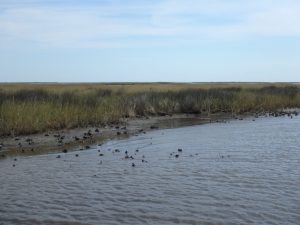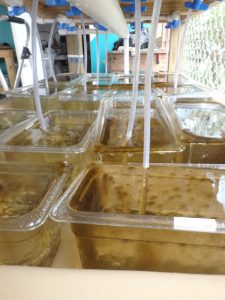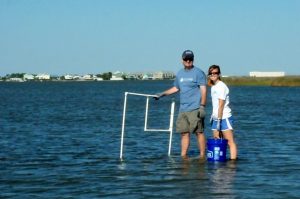Study Finds Low Salinity May Mitigate Oil and Dispersant Effects on Oysters
– FEBRUARY 5, 2019
Researchers conducted mesocosm experiments that examined how juvenile eastern oysters respond to salinity variations in the presence of oil and dispersed oil. Oil and dispersants were detrimental to oyster survival and growth, and the effects varied depending on salinity. Increased genetic diversity appeared to yield higher oyster survival; however, oil and dispersed oil decreased survival, regardless of genetic diversity, with dispersed oil having the greatest effect on survival. Medium-low salinity (15–20 ppt) magnified negative effects; however, low salinity (5–10 ppt) mitigated mortality, with survival being about 40% greater in low- than in medium-low salinity conditions. Growth was negatively affected by oil and dispersed oil, and treatments with medium-low salinity exhibited better growth than low salinity. The authors hypothesize pulsed freshwater flow may temporarily protect against contaminant uptake, via temporary cessation of filtering activities, and protect oyster recruitment and, therefore, oyster populations in affected areas. The results also suggest that promoting and maintaining oyster genetic diversity may buffer environmental disturbance and/or change.
The researchers published their findings in PLoS ONE: Short-term low salinity mitigates effects of oil and dispersant on juvenile eastern oysters: A laboratory experiment with implications for oil spill response activities.
Nearshore habitats such as oyster reefs are valued worldwide for their variety of ecosystem services. Successive reproduction and settlement provides food, shelter, and habitat for other organisms and improves water quality and stabilizes bottom habitats. The eastern oyster (Crassostrea virginica) is one of the most economically important shellfish species in the Gulf of Mexico. During the Deepwater Horizon incident, fresh water diversions were initiated to push affected waters away from the coast; coastal oyster reefs likely experienced exposure to oil, dispersant, and extended very low-salinity.
The researchers simulated a pulsed oil disturbance to nearshore/coastline oyster beds using a closed mesocosm system and tested the effects of multiple stressors on oyster survival and growth. After breeding offspring from five different pairs of eastern oysters in a lab, the team manipulated genetic diversity and conducted exposure trials.
Surrogate oil for Macondo 252 was added to the systems at 1 ppt (1 ml oil per 1 L water) to ensure oyster exposure (after predicted losses resulting from adsorption to the tanks and system plumbing). Though the 1 ppt oil concentration may seem high, the resultant polycyclic aromatic hydrocarbon and total petroleum hydrocarbon concentrations encountered in mesocosms (<0.03 mg/L and <18 mg/L, respectively) were less than those reported for coastal waters during the oil spill (Wade et al., 2016 and Sammarco et al., 2013) after 48 hours and were below concentrations thought to produce adverse biological effects (>4022 ng/g).
Dispersed oil treatments were initiated at an oil to dispersant ratio of 1:20 (the manufacturer recommended ratio) using the dispersant SlickGone (substituted for Corexit). Following exposure, researchers measured live oysters’ shell heights to assess growth and analyzed water samples collected 1-48 hours and 3-14 days after treatment for hydrocarbon concentrations.
The authors suggested that a pulse of low-salinity may be a viable short-term mitigation option in the event of an oil spill or other similar disturbance if (1) filtration uptake is the main mechanism for negative effects on oysters, (2) the length of low salinity exposure is not long enough to lead to oyster death via starvation or other mechanisms, and (3) the water temperature is relatively lower than warm summer temperatures. The authors cautioned that, as with all mitigation decisions, consideration be given to the costs and benefits of freshwater flow effects for other organisms and habitats.
Data are publicly available through the Gulf of Mexico Research Initiative Information and Data Cooperative (GRIIDC) at doi:10.7266/N7VQ30QZ.
The study’s authors are Meagan Schrandt, Sean Powers, F. Scott Rikard, Wilawan Thongda, and Eric Peatman.
By Nilde Maggie Dannreuther and Stephanie Ellis. Contact maggied@ngi.msstate.edu with questions or comments.
************
This research was made possible in part by a grant from the Gulf of Mexico Research Initiative (GoMRI) to the Alabama Center for Ecological Resilience (ACER).
The Gulf of Mexico Research Initiative (GoMRI) is a 10-year independent research program established to study the effect, and the potential associated impact, of hydrocarbon releases on the environment and public health, as well as to develop improved spill mitigation, oil detection, characterization and remediation technologies. An independent and academic 20-member Research Board makes the funding and research direction decisions to ensure the intellectual quality, effectiveness and academic independence of the GoMRI research. All research data, findings and publications will be made publicly available. The program was established through a $500 million financial commitment from BP. For more information, visit https://gulfresearchinitiative.org/.
© Copyright 2010-2019 Gulf of Mexico Research Initiative (GoMRI) – All Rights Reserved. Redistribution is encouraged with acknowledgement to the Gulf of Mexico Research Initiative (GoMRI). Please credit images and/or videos as done in each article. Questions? Contact web-content editor Nilde “Maggie” Dannreuther, Northern Gulf Institute, Mississippi State University (maggied@ngi.msstate.edu).








